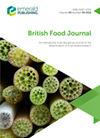Parents' and teachers' perceptions of the Australian primary school food provision venues and food-related policies
IF 3.4
3区 经济学
Q1 AGRICULTURAL ECONOMICS & POLICY
引用次数: 0
Abstract
Purpose This study aims to gain an understanding from parents and teachers about the types of food provision practices and venues, and the food-related policies and rules in primary schools in Australia; and investigate any differences in the presence of policies and rules based on the school location and school type. Design/methodology/approach Data were collected via two online surveys from August 2019 to March 2020. Descriptive statistics were employed to analyse quantitative responses. Respondents' written responses to food-related policies were categorised into groups. Findings The two most common food provision services were canteen and lunch order services (mentioned by 72 and 55% of respondents, respectively). Of the 425 respondents whose schools had a canteen (parents and teachers together), 62% reported their school implements a healthy school canteen policy. Significantly more parents compared to teachers, and more respondents from government schools compared to non-government schools stated that their school had implemented such a policy. Approximately half of the respondents (47%) stated their school had implemented other food-related policies and/or rules. These policies or rules belonged to four categories: avoiding certain foods, avoiding food sharing, avoiding food packages and promoting healthy eating. Originality/value This study shows the disparities exist in implementing food-related policies among primary schools in Australia. Nutrition promoters and policy planners should consider these results and find the best mechanisms to minimise the gaps in policy implementation.家长和教师对澳大利亚小学食品供应场所和食品相关政策的看法
本研究旨在从家长和老师那里了解澳大利亚小学的食物供应方式和场所的类型,以及与食物有关的政策和规则;并根据学校位置和学校类型调查政策和规则的存在差异。设计/方法/方法数据通过2019年8月至2020年3月的两次在线调查收集。采用描述性统计分析定量反应。受访者对食品相关政策的书面答复被分为几组。调查结果两项最常见的食物供应服务为食堂及订餐服务(分别有72%及55%受访者提及)。在425名学校设有食堂(家长和老师一起)的受访者中,62%的人表示他们的学校实施了健康的学校食堂政策。与教师相比,更多的家长表示他们的学校实施了这样的政策,而来自公立学校的受访者比来自非政府学校的受访者更多。大约一半的受访者(47%)表示,他们的学校已经实施了其他与食品相关的政策和/或规定。这些政策或规则分为四类:避免某些食物,避免食物共享,避免食品包装和促进健康饮食。原创性/价值本研究显示了澳大利亚小学在实施食品相关政策方面存在的差异。营养促进者和政策规划者应该考虑这些结果,并找到最佳机制,以尽量减少政策实施中的差距。
本文章由计算机程序翻译,如有差异,请以英文原文为准。
求助全文
约1分钟内获得全文
求助全文
来源期刊

British Food Journal
工程技术-食品科技
CiteScore
6.90
自引率
15.20%
发文量
219
审稿时长
18-36 weeks
期刊介绍:
After 115 years, the British Food Journal (BFJ) continues to be highly respected worldwide for its broad and unique interdisciplinary coverage of the latest food-related double blind peer-reviewed research. It links all sectors of this dynamic industry, keeping abreast of emerging trends, topical and controversial issues and informing and stimulating debate. - See more at: http://emeraldgrouppublishing.com/products/journals/journals.htm?id=bfj#sthash.O3wH4pEh.dpuf
 求助内容:
求助内容: 应助结果提醒方式:
应助结果提醒方式:


